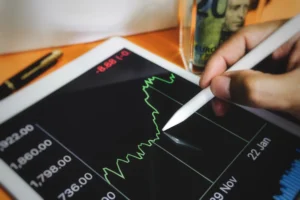Gamma in investing is one of the most valuable yet misunderstood ideas in options trading. It describes how much an option’s Delta changes when the price of the underlying asset moves by one unit. In simple language, while Delta measures how much an option’s price moves in response to the market, Gamma shows how fast that sensitivity itself changes. For investors and traders alike, understanding Gamma in investing is key to grasping how options react under different conditions.
Gamma is part of a group known as the Options Greeks Explained in trading. These metrics help investors measure how sensitive their options are to factors like price movement, volatility, and time decay. Gamma specifically focuses on acceleration—how quickly exposure increases or decreases as the market shifts. For beginners, this makes Gamma a critical concept because it reveals how much control or risk exists in an open position.
Traders who ignore Gamma often find their positions changing faster than expected. Gamma accelerates Delta’s effect, causing a trade that appears stable at one moment to suddenly shift into profit or loss territory. Knowing how Gamma behaves means being prepared for these shifts before they happen. That foresight separates disciplined investors from reactive ones. Understanding Gamma in investing helps traders stay consistent and confident in all kinds of markets.
Understanding the Core Concept of Gamma in Options Trading
Gamma in Options Trading measures how much Delta—the first-order sensitivity of an option’s price—changes with each movement in the underlying asset. To understand this, think of driving a car. Delta is your speed, while Gamma is your acceleration. Speed tells you how fast you are going, but acceleration tells you how quickly that speed increases or decreases. In trading, Gamma tells you how fast your position’s risk exposure changes.
If a call option has a Delta of 0.50 and a Gamma of 0.08, and the stock price rises by one dollar, the Delta increases to 0.58. Delta becomes 0.66 if the stock rises by one more dollar. That acceleration in Delta shows how quickly the position becomes more sensitive to price movements. The same principle works in reverse if prices fall. This phenomenon is what makes Gamma such an essential measurement in dynamic markets.
Gamma is highest when the option is at-the-money because every small change in price significantly impacts the probability of finishing in or out of the money. Deep in-the-money or far out-of-the-money options have lower Gamma because their outcomes are more certain. Understanding this relationship helps traders manage how aggressively their exposure shifts. In practical terms, Gamma in options trading tells you when to expect calm or chaos in your portfolio.
Importance of Gamma in Investing for Risk Management
Gamma in investing plays a vital role in understanding risk and reward. It allows traders to predict how quickly their exposure might change if the market moves. This aspect is especially valuable for those who use leveraged or short-term strategies. A position with high Gamma can turn profitable fast but can also lose value just as quickly. Therefore, traders who monitor Gamma can adjust positions before volatility becomes dangerous.
Long options, whether calls or puts, have positive Gamma. This means Delta moves in the trader’s favor when the market moves strongly in one direction. Short options have negative Gamma, meaning Delta moves against the trader when prices shift. For beginners, this distinction is crucial. Holding short options in a high-gamma environment can lead to fast, unpredictable losses. Conversely, long options can benefit from these quick changes if managed well.
Gamma also reveals when a portfolio becomes too reactive. If Delta swings too much for small price changes, exposure may be too aggressive. Adjusting the mix of long and short options can bring Gamma to a safer range. Understanding how Gamma interacts with Delta gives investors an early warning system before risk escalates. In volatile markets, this knowledge often determines whether a strategy survives or collapses.
The Delta and Gamma Relationship in Options Trading
The Delta and Gamma relationship forms the foundation of options pricing behavior. Delta measures the rate at which an option’s price changes relative to the underlying asset. Gamma measures how much that Delta itself changes when the underlying price moves. Together, they create a nonlinear relationship between the option’s value and the underlying asset’s movement.
When Gamma is high, Delta shifts quickly. This means small movements in the underlying area can make the position behave very differently. Traders who manage portfolios must understand this interaction to maintain balance. For example, if the underlying stock rises, a call option’s Delta increases, making it act more like the stock itself. If the stock falls, Delta decreases, reducing sensitivity. Gamma measures the speed of this entire process.
The Delta and Gamma Relationship also explains why hedging is necessary. Because Delta changes constantly, traders must rebalance their positions to maintain neutrality. A profound understanding of how Delta and Gamma move together helps predict when adjustments are needed. For beginners, learning this relationship turns complex trading behavior into understandable cause-and-effect reasoning, which is essential for building confidence in decision-making.
Gamma and Market Volatility Explained
Gamma behaves differently depending on volatility levels in the market. When volatility is high, Gamma values rise. The phenomenon happens because uncertainty increases the potential for rapid price swings, making Delta shift more frequently. In quiet markets, Gamma remains low because price movements are smaller and more predictable.
At-the-money options have the highest Gamma during periods of high volatility. This makes them extremely reactive to small price movements. Traders holding short options during these times must hedge more often, while those with long options may benefit from accelerated price responses. This sensitivity is what makes volatility events both profitable and risky.
Beginners should observe how Gamma changes around major market events such as earnings releases, central bank announcements, or geopolitical developments. These events often cause gamma spikes that change how options are priced. By tracking Gamma alongside implied volatility, traders gain insight into how quickly exposure may change. This understanding helps identify when it’s safer to enter or exit trades and how to prepare for uncertain conditions.
How Gamma Hedging Strategy Works in Practice
The Gamma Hedging Strategy is a professional method used to control exposure from changing Deltas. It involves buying or selling the underlying asset to keep the total Delta near zero as prices fluctuate. This balancing process ensures that portfolio risk remains stable even in fast-moving markets.
If a trader sells options, the portfolio will have negative Gamma. In this case, as prices move, Delta shifts in the opposite direction, increasing risk. To offset this, traders buy or sell the underlying asset accordingly. When Gamma exposure is neutralized, the trader avoids sudden large losses from sharp price changes. This constant rebalancing is the essence of gamma hedging.
While the Gamma Hedging Strategy may sound advanced, its logic benefits beginners too. Even without executing hedges, understanding how and why professional traders use them helps new investors interpret market behavior. For instance, sudden rallies or drops may occur because large institutional traders are adjusting Gamma-heavy positions. Knowing these factors gives traders perspective on volatility they might otherwise mistake as random.
Gamma and the Options Greeks Explained
Gamma is one part of the broader framework of options Greeks explained in trading. These Greeks—Delta, Gamma, Vega, Theta, and Rho—collectively describe how options respond to market factors. Gamma stands out because it connects directly with Delta and acts as a bridge between price movement and sensitivity.
Each Greek has a specific role. Delta reflects price direction, Vega measures volatility impact, Theta tracks time decay, and Rho deals with interest rate influence. Gamma interacts with all of them. When volatility rises, Gamma and Vega often increase together. When time decay accelerates, Theta and Gamma interact to influence near-term options. This complex balance defines how options pricing evolves across changing conditions.
Understanding these interactions helps traders avoid one-dimensional strategies. Beginners who study Gamma alongside the other Greeks learn to see trading as a system rather than a series of guesses. This well-rounded view builds resilience and consistency, which are essential traits for long-term success in options trading.
Real-World Example of Gamma in Investing
Imagine a trader buys an at-the-money call option on a stock priced at 100 dollars. The Delta is 0.50, and the Gamma is 0.10. If the stock rises to 101, Delta increases to 0.60. If it climbs again to 102, Delta becomes 0.70. Each price movement makes the option more sensitive, accelerating its behavior.
If the trader holds this position without adjustment, small market changes could lead to big fluctuations in exposure. This phase is where understanding Gamma makes a difference. If the market moves against the trader, Delta drops quickly, protecting part of the position automatically. If the market continues upward, Gamma magnifies profits. This dynamic showcases both the power and risk of Gamma-driven trades.
In contrast, a market maker holding short options must manage this effect carefully. Rising Gamma increases the need for frequent hedging. By constantly adjusting the underlying position, the trader maintains Delta neutrality and limits unexpected losses. This constant act of balancing defines professional-level risk control in options trading.
How Time Affects Gamma Behavior
Time is a major factor influencing Gamma in investing. As expiration approaches, Gamma for at-the-money options rises steeply. This situation happens because time decay compresses the value of out-of-the-money and in-the-money options, leaving at-the-money contracts more reactive to small price changes.
This increased sensitivity is both an opportunity and a risk. For traders holding long options, high Gamma near expiration can deliver quick profits if the price moves favorably. For short sellers, the same effect can cause sudden losses. Therefore, knowing how Gamma behaves across time helps traders choose expiries suited to their risk appetite.
Far-dated options, with longer expirations, have lower Gamma and respond more slowly to price changes. Investors seeking stability prefer these options. In contrast, short-term options have higher Gamma and are suitable for traders who can monitor positions closely. Understanding time’s influence on Gamma helps structure strategies that align with personal goals and tolerance for risk.
How Professionals Use Gamma to Manage Portfolios
Professional traders use Gamma as a core metric for risk and liquidity management. Hedge funds, market makers, and proprietary trading desks constantly calculate Gamma exposure to forecast how portfolios will react under different scenarios. Automated systems continuously rebalance Delta positions based on changing Gamma levels.
When overall market Gamma is high, institutional traders expect larger price swings as everyone adjusts simultaneously. This occurrence often happens near major expirations, creating sudden surges or drops in asset prices. Understanding these dynamics allows professionals to anticipate liquidity stress and plan accordingly.
For beginners, studying how professionals apply Gamma provides perspective on how institutional behavior shapes market trends. Gamma is not just a technical detail—it’s a reflection of how financial systems manage uncertainty. By learning from these practices, retail traders can make smarter, steadier decisions that mirror institutional discipline.
Managing Risk with Gamma Insights
Managing risk effectively starts with understanding how gamma in investing affects exposure. Gamma tells traders how quickly their Delta and overall portfolio sensitivity change with price movements. Monitoring this relationship allows more informed control over leverage, position size, and hedging frequency.
Traders can use gamma readings to identify when a position becomes too reactive. When Gamma grows too large, even small market moves can cause major swings in value. Adjusting the mix of long and short positions or changing strike selections can reduce volatility. Similarly, combining Gamma analysis with Vega and Theta helps traders balance multiple forces affecting options prices simultaneously.
By treating Gamma as an early-warning system rather than a theoretical number, traders can anticipate volatility instead of reacting to it. This proactive mindset leads to better stability, smoother performance, and improved long-term profitability.
Learning Gamma Step by Step as a Beginner
Beginners learning Gamma in investing should focus on observation and repetition. Start with demo platforms or paper trading accounts to see how Delta and Gamma interact. Watch how Delta changes faster when the option is near the strike price or when volatility rises. Gradually, patterns become visible, and Gamma’s role feels intuitive.
Next, experiment with small trades to see real-time Gamma effects. Track how exposure changes when prices move one or two percent. Record how time to expiration influences Gamma behavior. Over weeks of tracking, beginners begin to feel how Gamma connects theory to experience.
This gradual learning process transforms numbers into awareness. Once traders recognize how Gamma accelerates Delta changes, they become less emotional during market swings. They begin managing positions logically rather than reactively, which is the mark of a developing professional.
Gamma During News and Economic Events
Gamma often increases dramatically around major news announcements. Events such as central bank meetings, inflation data releases, or corporate earnings reports create uncertainty that pushes implied volatility higher. As volatility rises, Gamma follows, making options extremely sensitive to even minor price shifts.
Professional traders anticipate these spikes and adjust exposure in advance. They reduce short Gamma positions or hedge aggressively to avoid losses. After the event, when uncertainty fades, Gamma decreases quickly, and markets stabilize. Understanding this behavior helps traders avoid entering risky positions at the wrong time.
For beginners, watching Gamma before and after scheduled events provides clear lessons about market psychology. It shows how professional traders use Gamma not just to measure risk but to forecast opportunity windows in uncertain times.
Frequently Asked Questions (FAQ)
What is Gamma in simple terms?
Gamma measures how much an option’s Delta changes when the underlying asset price moves by one point. It shows how swiftly exposure changes.
Why is Gamma important in trading?
Gamma in Options Trading helps traders predict how their positions will behave under volatility. It identifies how quickly risk might increase or decrease.
What is the relationship between Delta and Gamma?
The Delta and Gamma Relationship defines how sensitive an option’s price is to movement. Delta measures direction, while Gamma measures acceleration of that change.
How do traders manage gamma risk?
Through a Gamma Hedging Strategy, traders buy or sell the underlying asset to keep Delta neutral and limit exposure during market fluctuations.
Do beginners need to understand Gamma before trading?
Yes, learning Gamma in investing helps beginners build awareness of how quickly risk changes. It prevents emotional trading and improves strategy control.
Final Thoughts
Gamma in investing is more than an advanced technical term—it’s the heart of understanding how options behave in the real market. It reveals how quickly risk transforms, how positions accelerate, and how professionals manage uncertainty through structure. For beginners, learning Gamma builds the foundation for smarter, steadier trading.
When traders understand Gamma, they no longer fear volatility; they read it. Every price swing becomes information instead of chaos. Gamma connects the art and science of trading, making it essential for anyone serious about long-term success in options and investing.
Read here to learn more about “How De-Dollarization Could Transform Global Financial Stability“

I’m Chaitali Sethi — a seasoned financial writer and strategist specializing in Forex trading, market behavior, and trader psychology. With a deep understanding of global markets and economic trends, I simplify complex financial concepts into clear, actionable insights that empower traders at every level. Whether it’s dissecting winning strategies, breaking down market sentiment, or helping traders build the right mindset, my content bridges the gap between information and implementation.




